FEATURE ARTICLES
The following feature articles appear in detail in the publication.
SKILLS SHORTAGES IN WESTERN AUSTRALIA - PART 2
This article will expand on the previous analysis published in the December quarter 2005 edition of this publication, which identified the existence and extent of the skills shortage across the economy. It will investigate the factors contributing to the shortage of skilled labour in the state and the impact it has had on the Western Australian economy, focusing on why many occupations have experienced a growing number of skilled vacancies between 2001-02 and 2004-05.
HOUSEHOLD EXPENDITURE IN WESTERN AUSTRALIA
This analysis provides some insight into recent expenditure patterns of Western Australian households by examining results from the 2003-04 Household Expenditure Survey (HES) released in August 2005. The results of the survey, which is conducted every five years, are used to highlight differences in spending for households with a range of social and demographic characteristics and present comparisons between the expenditure patterns of Perth and regional Western Australian households. State specific changes in consumer spending over time are also examined along with differences in expenditure patterns between Western Australia and Australia.
OVERVIEW
ECONOMIC SUMMARY
Western Australia's domestic economy continued its recent acceleration of growth in the December quarter 2005, with State Final Demand (trend chain volume terms) increasing by 2.8%, slightly higher than the 2.7% growth recorded in the previous quarter. The December quarter result was more than double the 1.2% increase in Australia's Domestic Final Demand and the highest growth of all states and territories. In seasonally adjusted chain volume terms, growth in the state economy in the December quarter 2005 (4.5%) was the highest recorded since the March quarter 2001 (6.2%). Growth during the quarter was driven by private business investment (up $672 million or 13.9%), supported by investment in oil and gas projects. Rising labour and materials costs in housing construction contributed to an increase of $103 million (7.2%) in expenditure on dwellings. In contrast, the sale of assets by state and local government contributed to a fall of $45 million (10.1%) in general government investment.
The value of exports from Western Australia increased by 27.2% ($2,584 million) through the year to December quarter 2005 to reach $12,092 million. Strong demand from China contributed to a rise of $1,573 million (91.4%) in the value of iron ore exports, mainly due to higher prices, although export volumes also increased by 11.2% over the period. Growth in prices drove increases in the export values of crude petroleum oil and combined confidential items, up $239 million (20.0%) and $237 million (13.5%) respectively. The value of imports to Western Australia rose by 17.2% ($601 million) through the year to December quarter 2005 to reach $4,093 million. The largest rise in the value of imports over the period was recorded for non-monetary gold, up $224 million (58.2%), largely due to growth in prices.
The outlook for Western Australian exports remains positive, with greater than expected recent growth in the US and Japanese economies, and the Chinese economy continuing to expand at a rapid pace. In addition, high global commodity prices can be expected to provide a favourable environment for continued export growth.
Employment growth eased in Western Australia in the three months to February 2006, with the trend estimate of employed persons rising by 0.2%, following an increase of 0.4% over the previous three month period. Driving employment growth in the state over the period was a 0.8% increase in full-time employment. The industries showing the largest growth in employment in the February quarter 2006 were Construction (up 12,165 or 12.2%) and Retail trade (up 6,417 or 4.4%). Unemployment increased in Western Australia over the three months to February 2006, with the trend estimate of unemployed persons rising by 1.9% (846 persons), following a fall of 6.6% (3,187 persons) in the previous three months. The slight rise in the number of unemployed persons in the state has seen the unemployment rate (trend) stabilise at 4.1% in February 2006, well below the national rate of 5.2%.
STATE ACCOUNTS
State final demand
State Final Demand in Western Australia increased by 2.8% in the December quarter 2005 (trend chain volume terms), slightly higher than the 2.7% growth recorded in the previous quarter. Growth in the state's domestic economy was fairly steady between the December quarter 2003 and the March quarter 2005, averaging 1.5% per quarter, but has accelerated since the June quarter 2005 to average 2.6% over the last three quarters. Growth in Western Australia's State Final Demand in the December quarter 2005 (2.8%) was more than double growth in Australia's Domestic Final Demand (1.2%) and the highest growth of all states and territories.
STATE FINAL DEMAND, Chain volume measures - Change from previous quarter

In seasonally adjusted chain volume terms, Western Australia's State Final Demand increased by 4.5% in the December quarter 2005, the strongest growth recorded since the March quarter 2001 (6.2%). The main contributor to growth during the quarter was private business investment, which rose by $672 million (13.9%), driven by strong growth in new engineering construction (up $415 million or 33.8%) and new machinery and equipment (up $235 million or 8.4%), supported by investment in oil and gas projects including the fifth LNG train of the North West Shelf Project. Rising labour and materials costs in housing construction contributed to an increase of $103 million (7.2%) in expenditure on dwellings during the quarter. Other notable contributions to growth in the December quarter 2005 were household final consumption expenditure (up $153 million or 1.2%); public corporations (up $60 million or 12.1%), mainly due to increased spending by state and local governments on public housing, electricity, gas and water; and government final consumption expenditure (up $48 million or 1.4%), largely due to increased national government spending on defence. In contrast, the sale of assets by state and local government contributed to a fall of $45 million (10.1%) in general government investment.
PRICES
Consumer Price Index
Growth in Perth's Consumer Price Index (CPI) eased slightly in the December quarter 2005 to 0.8%, following an increase of 1.0% in the previous quarter. Nationally, the weighted average CPI rose by 0.5% in the December quarter. The major contributors to Perth's CPI growth were house purchase (up 3.9%), domestic holiday travel and accommodation (up 4.4%) and deposit and loan facilities (up 2.5%). Strong demand for housing in Perth saw the city record the largest increase in housing costs of all capitals during the quarter, driven by rising prices for labour and materials. Increases in some banking charges such as account keeping and transaction fees contributed to the rise in deposit and loan facilities. Partially offsetting CPI growth in Perth in the December quarter 2005 were notable price falls for audio, visual and computing equipment (down 3.8%), automotive fuel (down 1.1%) and overseas holiday travel and accommodation (down 1.6%).
CONSUMER PRICE INDEX (ALL GROUPS), Change from same quarter previous year
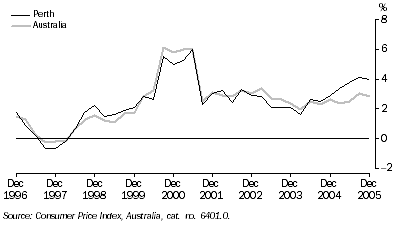
Perth's CPI increase of 4.0% through the year to December quarter 2005 was the largest increase of all capital cities and well above the weighted average rise of 2.8%. Strong growth in the purchase price of new houses in Perth through the year drove a 9.3% increase in housing costs, more than double the weighted average increase of 3.6%. The national average CPI increase of 2.8% over the year was within the Reserve Bank of Australia's (RBA) target range of 2.0%-3.0% for inflation. The RBA expects underlying prices to increase gradually over the year ahead and has identified the main inflationary pressures as rising wages and labour costs, as well as increases in the prices of administered items such as health, education and utilities.
Wage Price Index
Western Australia's quarterly index of total hourly rates of pay excluding bonuses rose by 4.2% through the year to December quarter 2005. After peaking at 5.0% through the year to June quarter 2005, well above the national increase of 4.1%, annual wages growth in the state eased over the past two quarters to be only slightly higher than the national increase of 4.1% in the current period.
WAGE PRICE INDEX, Change from same quarter previous year
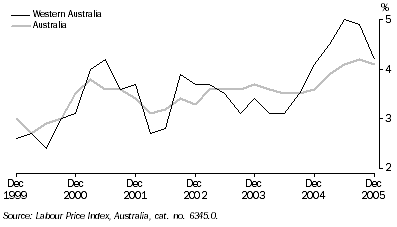
Strong demand for labour in Western Australia, particularly in the construction and resources sectors, continues to drive wages growth in the state. The relative strength of Western Australia's housing market contributed to an 8.7% increase in annual wages growth for Construction, the highest among the selected industries in the state and almost double the next highest increase of 4.8% for Education. Mining and Manufacturing (both up 4.6%) also recorded strong annual wages growth in the current period. The occupations recording the highest annual wages growth in Western Australia through the year to December quarter 2005 were Associate professionals (up 5.0%), Labourers and related workers (up 4.7%) and Managers and administrators (up 4.6%).
CONSUMPTION
Retail trade
Retail turnover (trend) in Western Australia increased by 0.6% ($32 million) in the three months to January 2006, compared to the previous three month period. Nationally, retail turnover increased by a slightly higher 0.8%. After peaking at 1.0% in June 2005, growth in Western Australia's retail turnover has been relatively flat since September 2005, averaging 0.2% per month to January 2006. Several factors may have contributed to the slowdown in retail spending in the state, including an easing in consumer sentiment throughout 2005, uncertainty about future movements in interest rates and households taking a more cautious approach to finance generally.
MONTHLY RETAIL TURNOVER, Current prices

Growth in retail turnover in Western Australia in the three months to January 2006 (compared to the three months to October 2005) was highest for household good retailing, up $14 million (1.5%), reflecting the relative strength of the state's housing market. Strong growth was also recorded for recreational good retailing, up $11 million (3.6%); clothing and soft good retailing, up $9 million (3.3%); and food retailing, up $6 million (0.2%). Conversely, turnover declined during the period for other retailing (including pharmaceuticals, cosmetics, antiques, garden supplies and jewellery), down $5 million (1.1%); hospitality and service industries, down $3 million (0.4%); and department stores, down $2 million (0.4%).
New motor vehicle sales
The trend estimate for sales of new motor vehicles in Western Australia fell for the third consecutive month in February 2006, decreasing by 0.6% to 8,670 vehicles. New motor vehicle sales began to decline in December 2005, following 24 consecutive months of growth since December 2003. Despite the decline, sales of new motor vehicles in the state remain near historically high levels.
NEW MOTOR VEHICLE SALES
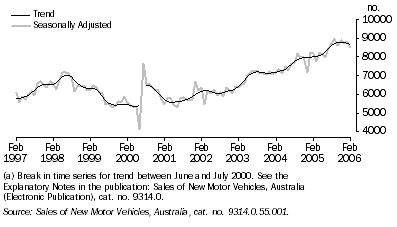
Over the three months to February 2006, sales of new motor vehicles (trend) in Western Australia fell by 0.7% (175 vehicles), compared to the previous three month period. Nationally, new motor vehicle sales fell by 0.3%. The state decline over the period was entirely due to a fall in sales of passenger vehicles (down 285 vehicles or 1.9%). In contrast, sales of sports utility vehicles increased by 63 vehicles (1.2%) and sales of other vehicles (including utilities, vans, trucks and buses) rose by 47 vehicles (0.8%) over the period.
INVESTMENT AND FINANCE
Private new capital expenditure
Business investment (trend chain volume terms) in Western Australia increased by 8.6% ($258 million) to $3,259 million in the December quarter 2005 - the highest level since the quarterly series began in the September quarter 1989. Investment grew strongly on equipment, plant and machinery (up 9.5% or $148 million) and buildings and structures (up 6.1% or $88 million) during the quarter, driven by the commencement of construction work on a number of resource-related projects. The development of infrastructure such as port upgrades, rail lines and gas pipelines to support these projects can be expected to facilitate further capacity expansions in the state's resources sector.
PRIVATE NEW CAPITAL EXPENDITURE, Chain volume measures

In original current price terms, business investment in Western Australia reached a record high of $3,918 million in the December quarter 2005, after rising through the year by 46.6% ($1,246 million). Strong growth was recorded for all industry groups through the year to December quarter 2005, particularly mining, up $890 million (62.2%); and, to a lesser extent, other selected industries (including retail, construction and property and business services), up $214 million (24.5%) and manufacturing, up $142 million (38.6%). Investment in the mining industry in the state totalled $2.3 billion in the December quarter 2005, supported by strong global demand for Western Australian commodities and associated high commodity prices.
Housing finance commitments
The number of housing finance commitments for owner occupation (trend) in Western Australia increased by 3.8% (942) in the three months to January 2006, compared to the previous three months, higher than the national increase of 3.1%. The total value of housing finance commitments (trend) in the state also increased over the period, rising by 7.5% ($346 million). Growth in housing finance commitments in Western Australia has now been sustained since the first half of 2004, with the number of commitments rising for 20 consecutive months since June 2004.
HOUSING FINANCE COMMITMENTS, Number of dwellings financed
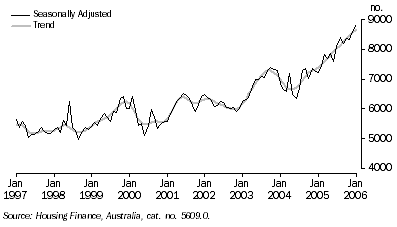
In original terms, the total value of housing finance commitments for owner occupation increased by 4.6% ($213 million) in Western Australia in the three months to January 2006, compared to the previous three month period. Growth was mainly driven by finance commitments for the purchase of other established dwellings, up $192 million (7.0%). The value of housing finance commitments for the construction of new dwellings rose by 1.2% ($8 million) over the period, wholly attributable to investors, up $31 million (37.5%); with owner occupiers falling by $23 million (3.8%). The increase in owner occupier commitments for the purchase of other established dwellings, coupled with the fall in commitments for the construction of new dwellings, provides some indication that owner occupiers are purchasing established homes rather than building. However, growth in the construction of new dwellings continues to be supported by investors, and can be expected to lead to continued growth in building approvals over the coming quarters.
CONSTRUCTION
Building approvals
The number of houses approved (trend) for construction in Western Australia increased by 4.7% (248 approvals) in the three months to January 2006, compared to the previous three month period. Nationally, the number of house approvals fell by 4.0%. The number of house approvals in the state has now increased for eight consecutive months since June 2005, although growth has eased from a high of 2.3% in September 2005 to 0.5% in January 2006. Despite the moderation in growth, the number of house approvals in Western Australia remained at a historically high level of 1,860 in January 2006 - the highest level since September 1988 (1,886).
NUMBER OF DWELLINGS APPROVED, Houses: Trend
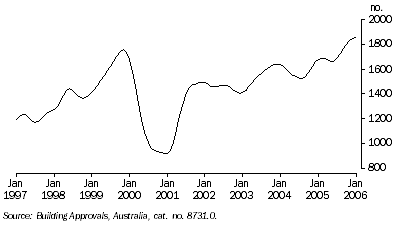
Coinciding with the increase in houses approved, the number of other dwellings (comprising non-house building) approved (trend) in Western Australia rose by 51.7% (479 approvals) in the three months to January 2006, compared to the previous three months. The recent strength in building approvals in the state, along with an increase in the value of new house construction activity yet to be done at the end of the September quarter 2005 (up 17.0% to $1,550 million), supports the likely continuation of high levels of housing construction activity for the remainder of 2006.
TRADE
The value of Western Australia's trade surplus increased by 33.0% ($1,983 million) through the year to December quarter 2005 to reach $7,999 million - the largest trade surplus in the last ten years. The increase was driven by strong growth in the state's exports (up $2,584 million), largely due to growth in resource commodity prices and, to a lesser extent, capacity expansions in the resources sector. The value of imports into Western Australia also increased over the period (up $601 million), supported by a strong domestic currency, coupled with high levels of consumer and business sentiment and business investment.
VALUE OF WESTERN AUSTRALIA'S TRADE SURPLUS, Change from same quarter previous year
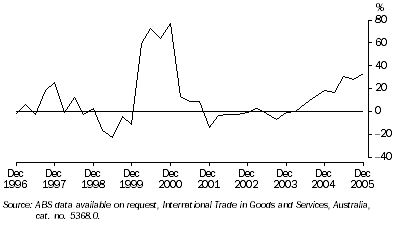
An increase in exports of iron ore from Western Australia contributed to significant improvements in the state's trade positions with China (surplus up $1,069 million to $2,302 million) and Japan (surplus up $960 million to $2,495 million) through the year to December quarter 2005. The state's trade surplus with the United Kingdom also rose over the period (up $417 million to $720 million), mainly due to an increase in exports of non-monetary gold. Conversely, a fall in exports of non-monetary gold contributed to declines in the state's trade positions with Thailand (surplus down $258 million to $187 million) and India (surplus down $218 million to $488 million). The state's trade surplus with the USA also decreased over the period (down $190 million to a deficit of $43 million), largely attributable to a fall in petroleum exports.
Exports
The value of Western Australia's exports increased by 27.2% through the year to December quarter 2005, to reach $12,092 million. Strong demand from China contributed to a rise of $1,573 million (91.4%) in the value of iron ore exports, mainly due to higher prices, although export volumes also increased by 11.2% over the period. Growth in prices drove increases in the export values of crude petroleum oil and combined confidential items, up $239 million (20.0%) and $237 million (13.5%) respectively, with export volumes falling for both commodities. The value of exports of non-crude petroleum oils and wheat both declined by $27 million (19.4% and 5.9% respectively) over the period, largely due to falls in export volumes.
Imports
The value of imports to Western Australia rose by 17.2% through the year to December quarter 2005, to reach $4,093 million. The largest rise in the value of imports over the period was recorded for non-monetary gold, up $224 million (58.2%), largely due to growth in prices. An increase of 30.5% in volume contributed to a rise of $154 million (69.1%) in the value of imports of non-crude petroleum oils. Conversely, increasing prices fuelled a rise in the value of imports of crude petroleum oils (up $107 million or 27.2%), with the volume of imports falling by 9.3%. The value of imports of medicinal and pharmaceutical products declined by $90 million (76.9%) over the period, largely due to a 50.4% fall in the volume imported.
MINING
Mineral and petroleum exploration expenditure
Mineral exploration expenditure (trend) in Western Australia fell for the third consecutive quarter in the December quarter 2005, down by 3.1% ($5 million). Despite the decline, mineral exploration expenditure in the state remains near historically high levels, supported by strong global demand for raw materials, particularly from China and other emerging economies, which has pushed commodity prices to record high levels.
MINERAL EXPLORATION EXPENDITURE, Total minerals
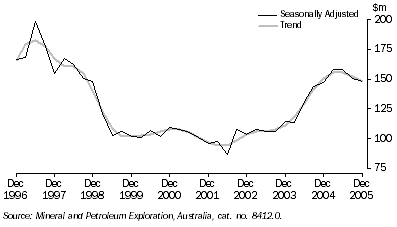
In original terms, Western Australia's expenditure on mineral exploration increased by 0.8% ($1 million) through the year to December quarter 2005. Driving growth over the period were increases in exploration expenditure on iron ore (up $6 million or 18.3%) and silver, lead, zinc (up $4 million or 633.3%). Exploration expenditure fell for all other selected minerals, with the largest decline recorded for gold (down $6 million or 9.5%).
Petroleum exploration expenditure (original) in Western Australia rose by 35.1% ($40 million) through the year to December quarter 2005. Although petroleum prices are relatively volatile and sensitive to unexpected events, recent strength in petroleum prices has stimulated exploration expenditure in the state.
Mineral and energy production
Production of many mineral and energy resources in Western Australia increased through the year to December quarter 2005. The largest growth was recorded in the production of zinc (up 266.7%), in response to recent strength in world prices. Production also increased for crude oil (up 17.9%) and iron ore (up 7.1%). The largest falls in production over the period were recorded in the production of diamonds (down 27.7%), reflecting maintenance activities at the Argyle mine as well as changes in processing practices; ilmenite (down 6.1%); and nickel (down 5.7%), in response to a recent softening in world prices.
TOURISM
Short-term arrivals on holiday
A total of 82,266 overseas visitors arrived in Western Australia by air on holiday in the three months to December 2005 - 5,248 (6.8%) more than in the same period of 2004. Visitor arrivals increased from all of the selected countries except Japan and Thailand, from which 770 (8.9%) and 601 (35.4%) fewer visitors arrived respectively. The largest increases in visitor arrivals over the period were from the United Kingdom (up 2,603 or 12.5%), Europe (up 696 or 6.3%) and Indonesia (up 513 or 21.8%).
SHORT-TERM VISITOR ARRIVALS AND RESIDENT DEPARTURES OVERSEAS, By air on holiday
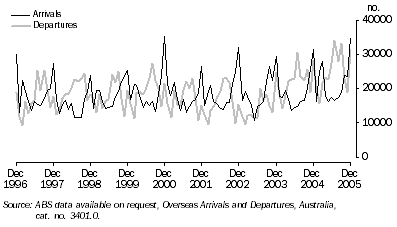
Short-term departures on holiday
The number of Western Australian residents departing by air on holiday overseas rose to 73,213 in the three months to December 2005, an increase of 636 (0.9%) from the same period of 2004. The rise in the number of residents departing overseas on holiday coincided with a fall in the price of overseas holiday travel and accommodation in the December quarter 2005. The largest increases in resident departures over the period were to Thailand (up 2,593 or 38.1%), Malaysia (up 1,524 or 27.2%) and the United States of America (up 1,468 or 53.2%). A large fall in resident departures to Indonesia (down 10,317 or 44.9%) followed the bombing in Bali on 1 October 2005. Falls were also recorded in resident departures to South Africa (down 211 or 14.8%) and Japan (down 71 or 9.3%).
LABOUR MARKET
Employment
Employment growth eased in Western Australia in the three months to February 2006, with the trend estimate of employed persons rising by 0.2%, following an increase of 0.4% over the previous three month period. Nationally, employment remained relatively unchanged over the three months to February 2006. Driving employment growth in the state over the period was a 0.8% increase in full-time employment, largely due to a rise of 1.5% in full-time employed females, as well as a 0.5% rise in full-time employed males. Despite slower growth in the last three months, there were 2,544 more persons employed in Western Australia in February 2006 than in November 2005.
EMPLOYED PERSONS, Total
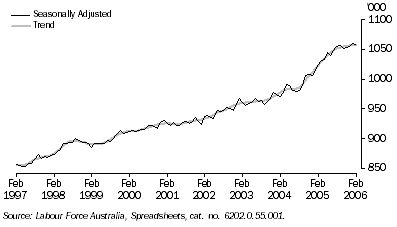
Industry Employment
Growth in employment in Western Australia was spread across approximately half the industries in the state in the February quarter 2006, compared to the previous quarter. The industries contributing most to employment growth were Construction (up 12,165 or 12.2%), Retail trade (up 6,417 or 4.4%) and Health and community services (up 5,068 or 4.9%). The largest falls in employment over the period were recorded by Education (down 9,772 or 13.4%), Mining (down 6,875 or 13.0%) and Transport and storage (down 4,095 or 8.3%).
Unemployment
Unemployment in Western Australia increased in the three months to February 2006, with the trend estimate of unemployed persons rising by 1.9% (846 persons). The rise follows falls of 6.6% (3,187 persons) and 8.1% (4,265 persons) over the three months to November and August 2005 respectively. The slight rise in the number of unemployed persons in the state has seen the unemployment rate (trend) stabilise at 4.1% in February 2006, well below the national rate of 5.2%.
UNEMPLOYMENT RATE
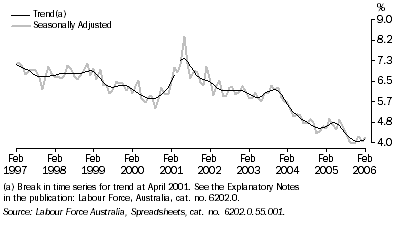
Participation
Participation in Western Australia's labour force remained relatively unchanged in the three months to February 2006, with 67.7% of the state's civilian population aged 15 years and over being either employed or actively seeking employment in February 2006, compared to 67.8% in November 2005.
 Print Page
Print Page
 Print All
Print All